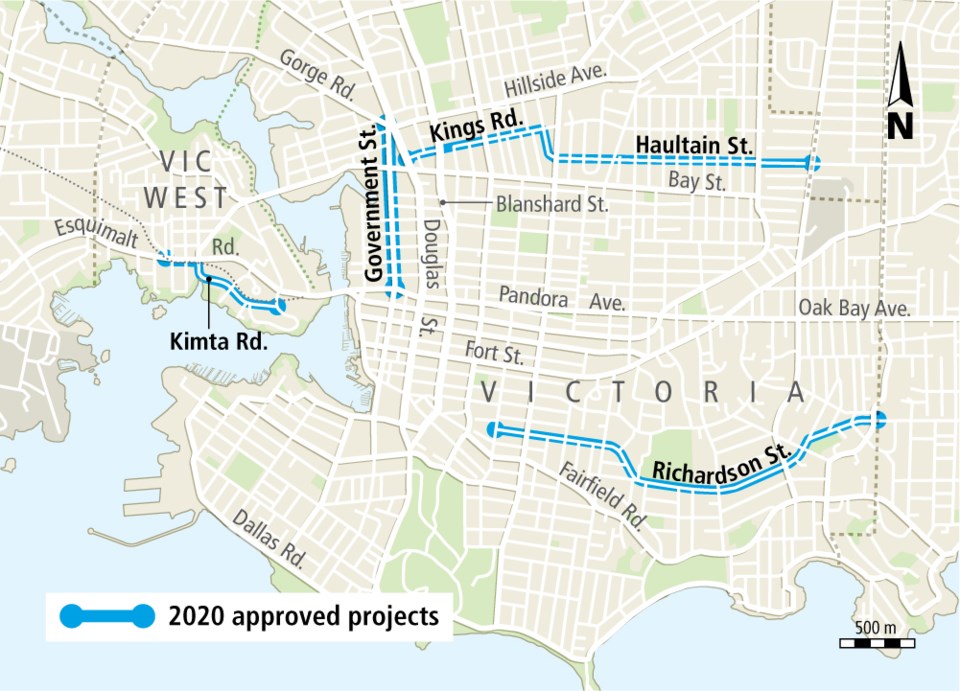Richardson Street changes will snarl traffic
Dismay, astonishment, disbelief — all words that sum up my view of the proposed closure of Richardson Street west from Foul Bay Road, plus diversions that will also affect eastbound traffic.
The proposal will take 5,000-6,000 vehicles per day off Richardson Street, increasing travel times by four to seven minutes per vehicle.
Where will they go? Given Oak Bay’s street configuration in this area, there are few choices — they will use Fairfield Road and Oak Bay Avenue and these will become even more congested.
Narrow, winding Foul Bay Road will be hugely affected, as will smaller streets that provide connections to Fairfield Road and Oak Bay Avenue. My neighbourhood will be overrun.
Why is this happening? To provide bike lanes on a street that has operated quite adequately for decades as a bike and vehicular route — Richardson Street is wide and can accommodate both.
Why is it possible for one municipality to close off a major inter-municipal route? Why hasn’t Victoria engaged in meaningful consultation with the District of Oak Bay and its affected residents?
This decision is both short-sighted and nonsensical.
Diana Butler
Oak Bay
Bike lanes have benefits for all
Re: “Richardson Street already safe bike route,” letter, July 15.
As I understand it, Victoria bike-lane plan, including Richardson Street, is not meant to provide a greater sense of comfort for existing cyclists like the letter-writer and me.
It is to provide an increased level of comfort for ages eight to 80 and all abilities. The goal is to create a safe route for those who would ride a bike, or use other forms of active transportation, if they felt safe from vehicle traffic.
Richardson Street will be one link in a network of quality, interconnected active transportation routes where the car is not primary. The outcome is that for every Victoria citizen who would like to ride a bicycle (or a mobility scooter, e-bike etc.) there is a nearby designated route that feels safe and inviting.
There are personal health benefits from choosing active transportation. And a bike can be fun, quick and efficient.
There are also broad-ranging community benefits. More bike trips means fewer car trips which can lower atmospheric carbon and related pollutants, including noise.
It can mean fewer collisions, lower insurance and even lower costs for roadway maintenance.
For those choosing to travel by car, more bikes also means fewer other cars, which means more available parking spots and reduced traffic congestion.
More citizens making the bicycle their transportation choice might even result in Fairfield Road becoming a little less ridiculous and confusing.
Stuart Walker
Victoria
New bike lanes remove risk of being ‘doored’
Re: “Richardson Street already safe bike route,” letter, July 15.
Some letter-writers say they feel safe riding their bikes on Richardson Street. I ride my bike in fear down that street because I have been “doored” (when a car door suddenly opens in front of a cyclist).
There are numerous parked cars on Richardson.
Car drivers often wonder why we cyclists ride our bikes down the middle of the road. It’s because we fear being doored.
I would be in heaven if there were a protected bike lane on Richardson Street as it’s a major artery from Oak Bay to downtown.
Linda Gould
Oak Bay
Fisheries enforcement needs more funding
Re: “Eight more projects set to receive funding for wild salmon restoration in B.C.,” July 14.
The story states there is a $143 million fund available to help our struggling Pacific salmon.
None of it seems to be allocated to regulation enforcement where, in my humble opinion, the funding is nothing short of pathetic.
I was fishing on the opening day for chinook salmon locally, I witnessed several boats landing, quite clearly, undersized salmon and not returning them to the ocean.
I think it is fair to assume they were chinook because nothing else was biting. My fishing partner and I released, as gently as possible, numerous chinook just under the minimum length and only boated one that was legal.
Later, at the dock, I saw about 15 carcasses on the beach that appeared to be chinook. All were under the legal-size limit.
If there was any chance of being caught, nobody in their right mind would risk filleting, in full public view, a quantity (obviously exceeding the daily one-fish limit) of illegal fish.
Perhaps Ottawa should reconsider the allocation of some of this fund to hire and equip more enforcement officers in an effort to reduce poaching.
Michael Fall
Cassidy
Send us your letters
• Email: letters@timescolonist.com
• Mail: Letters to the editor, Times Colonist, 2621 Douglas St., Victoria, B.C. V8T 4M2.
Letters should be no longer than 250 words and may be edited for length, legality or clarity. Include your full name, address and telephone number. Avoid sending letters as an email attachment. Copyright of letters or other material accepted for publication remains with the author, but the publisher and its licensees may freely reproduce them in print, electronic and other forms.



